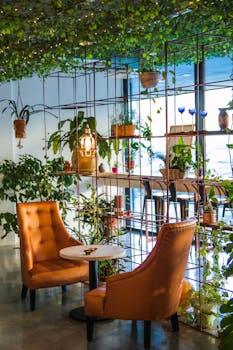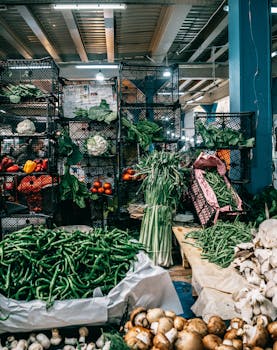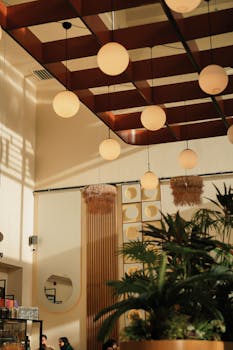Hanging planters are one of the cleverest methods of making use of vertical space on a balcony or outside wall. This is especially relevant when your home is small.
When you pair hanging baskets or pots with the right plants, it provides a very intriguing but relaxed look.
Hanging Planters Indoors
Hanging baskets are generally used on the exterior walls of your house, but they can also be used indoors. Using hanging baskets indoors comes with some challenges. One of these is to prevent water dripping out of the basket onto the floor.
To get around this, you either need a drip tray below the basket. Alternatively, if you have a basket that has no holes, you can put a pot with drainage holes in the basket. Remember, you need drainage holes to prevent mould in the soil.

Hooks
Unless it’s a wall-mounted planter, you will need a hook on which to hang your planter. Metal brackets secured to the wall with rawl bolts or dowels are the strongest option. It’s a good idea to apply a little weight to the hook to test it before use.
Choosing your Basket
There are a number of different types of hanging planters available. The main two main types are:
-
- Wire/mesh, to be used with liner. Very flexible and looks great.
-
- Solid-walled like clay, fibre or plastic. They don’t need as much watering but you can’t put plants on the sides if the pot doesn’t have holes on the side. Arguably doesn’t look as good as a wire basket with sphagnum moss.
Lining your Basket
If you have chosen a wire basket, you will need to find a liner. A liner is something that will fill the gaps in the basket and hold in the soil. There are a couple of options:
| Liner | Cost | Ease of planting | Appearance | Compost holding | Reusable | Side planting |
|---|---|---|---|---|---|---|
| Preformed wood fibre liner | Average | Easy | OK | Good | Yes | Difficult |
| Coconut fibre (coir) liner* | High | Easy | Good | Good | Yes | Difficult |
| Sphagnum Moss | High | Difficult | Very good | OK | No | Yes |
| Wool moss liner | Average | Good | Untidy | Need lots | No | Yes |
| Foam rubber liner | Low | Easy | Not great | Good | Yes | Difficult |
* Birds may use as a nesting material
Wire baskets with liners can lose a huge amount of water. Putting a piece of plastic (punched with some holes) between the growing medium and liner can slow down water loss.
Choose or Create a Potting Mix
Use potting mix rather than potting soil. Potting mixes can be bought at your local nursery and contain compost, peat moss, vermiculite, perlite and sand. Potting mix is lighter than soil, provides better air flow and water retention.
Choosing Good Hanging Basket Plants
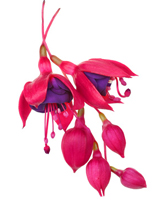
Nothing beats lovely, bright flowers in a hanging pot! Fuchsias are stunning flowering plants that will overflow the basket in a burst of incredible colour! Or how about a petunia hanging basket?
Growing strawberries in hanging baskets works well. And they’re tasty too!
Herbs are other edible plants you can put in a hanging basket, positioned outside in the sun or next to a bright window near the kitchen.
| Plant Type | Name | Light |
|---|---|---|
| Foliage Trailing | Glacier English Ivy* | Shade to part sun |
| Foliage and Flowering trailing | Vinca Vine | Full sun or partial shade |
| Foliage and Flowering Trailing | Variegated Creeping Charlie** | Full sun to partial shade |
| Flowering | Fuchsia | Bright, indirect |
| Flowering | Begonia | Full sun to shade |
| Flowering | Sweet pea | Full sun |
| Flowering Perennial | Flame violet | Bright, indirect |
| Flowering Trailing Perennial | Italian bellflower | Bright, avoid hot summer sun |
| Flowering Annual | Petunia | Full sun to partial shade |
| Flowering Trailing Perennial | Ivy Geranium | Bright to full sun |
| Flowering Trailing Perennial | Lobelia | Full or partial shade |
| Flowering Trailers | Verbena | Full sun |
| Flowering Trailing Perennial | Lantana | Bright to full sun |
| Edible Perennial | Strawberries | Full sun |
| Edible | Herbs (Basil, sage, thyme, marjoram, chives) | Full sun |
* toxic to pets
** considered a noxious weed in some areas
Tips
Here are some really useful tips to consider:
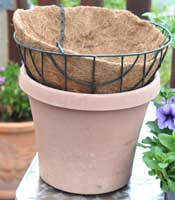
-
- Hanging planters are often round underneath making it difficult to keep upright during preparation. To help this, place the basket on top of an empty pot to stabilise it while planting.
-
- Mix plants to provide varying colour. Mix annuals and perennials for year-round colour.
-
- If you use “mounding” plants that don’t trail, combine them with a trailing foliage or flowering trailer to cover the basket.
-
- Bring your basket indoors before frost to prevent damage.
-
- Use a product such as Crystal rain (that transparent jelly sometimes used in vases) to improve the water retention of your potting mix. If you do, remember to wet them so they expand before planting. Otherwise you may misjudge the amount of potting mix required.
Planting
Once you’ve chosen your basket, got your liner (if you got a wire basket), chosen some plants and found or installed a suitable hook, you’re ready to get planting.
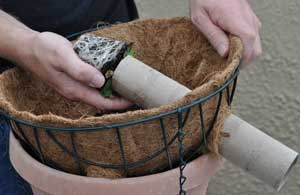
Steps:
-
- If you have a wire basket, put the liner in it.
-
- If you want to plant on the sides of your hanging basket, now is a good time to make holes for these plants. Thread seedlings through the holes carefully. Sphagnum moss is great for planting on the sides because you don’t need to make holes you just lay the moss to a certain level, put in some potting mix for support, place the seedling and continue with the moss. With coir liners, try using a used toilet roll to protect your plant as you feed it through the holes.
-
- Put some slow-release fertilizer in your potting mix.
-
- Put a base of potting mix in the container
-
- Take your plants out of their nursery bags and tease the roots to free them. Then place them on the soil and fill with potting mix up to about 5cm from the top. Pack lots of flowers in the hanging planter — you want a flurry of colour.
-
- Water the basket well and then place on the hook
Care
Water daily during hot weather. Keep the soil moist. Hanging planters, especially those made from natural materials, dry out very quickly.
With the frequent watering, you will need to fertilize every two weeks to replenish lost nutrients.
Sun loving plants will need more water than shade loving plants, because the sun dries out the soil far quicker. So shade-loving ones are lower maintenance.
Prune faded flower heads on a regular basis to promote continual growth.
Hanging Terrariums
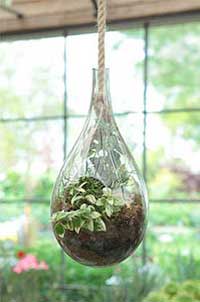
Ordinary hanging containers are just one way you can suspend your plants. Have you considered a hanging terrarium?
The hanging teardrop terrarium on the right is a delightful way to suspend a small plant in the smallest of spaces.
Hanging air plants (tillandsias) are plants that can be suspended to grow in the air without using a container.
Article source: http://www.beginner-indoor-gardening.com/hanging-planters.html
SHARE IT SO OTHERS CAN FIND THE BEST GARDENING INFO

